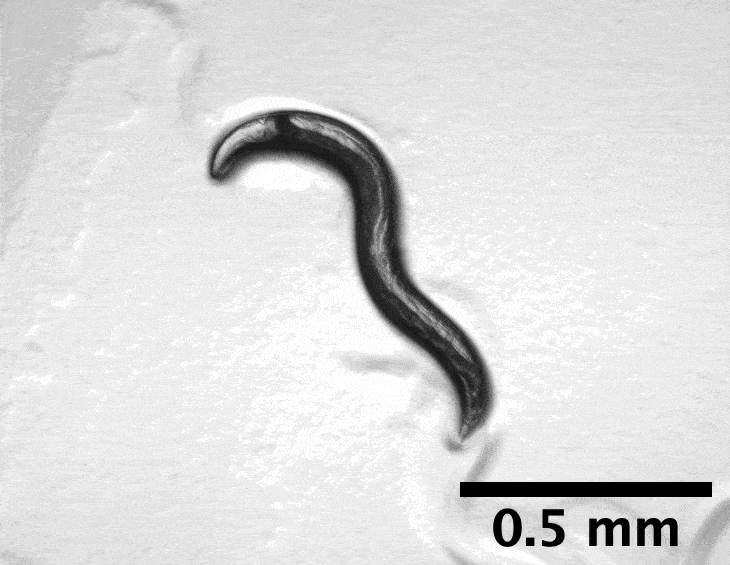Extreme Worms: Kavli-Grass Fellow Studies Super-Resistance to Arsenic Toxicity

The lake is three times as salty as the ocean, contains a thousand times more arsenic than is allowed in drinking water, and has the pH of liquid detergent.
It’s called Mono Lake. For one roundworm, it’s home.
Rockefeller University postdoctoral scientist James Lee was part of the team that discovered the roundworm Tokorhabditis tufae in the hostile California lake. Roundworms, also known as nematodes, are a strange bunch of creatures to begin with, but T. tufae is an oddity even among them. It is incredibly resistant to arsenic, able to withstand 150 times the typical lethal dose. It also does something very few nematodes can: give birth to live young.
Lee, a Kavli-Grass Fellow at the Marine Biological Laboratory (MBL) this summer, is investigating these aspects of T. tufae’s biology. He believes the two traits might be related, that live birth might help these nematodes survive in the harsh environment of Mono Lake. By exploring how this worm can survive such a high dose of arsenic, he hopes to establish it as a new research organism for extremophile biology. One day, this nematode may even help treat arsenic poisoning in the 230 million people who suffer from it worldwide.

Adapting to an extreme life
It’s not an exaggeration to say that nematodes are everywhere; they make themselves at home in ocean trenches, polar ice caps, a mile underground, and within our own intestines. So, when Lee joined the group of researchers going to survey Mono Lake’s harsh environment for nematodes, he said, “We knew that there were going to be worms there. And we knew two things. One, this would be great for extremophile biology…and number two, that we could get a great field trip out of this.”
He laughed. “It had a lot to do with the latter.”
The team was right — they found not one, but eight species of nematodes in Mono Lake. Tokorhabditis tufae, which was a new species at the time, stood out in particular for its high arsenic resistance and the unusual nematode behavior of live birth. The latter adaptation is especially fascinating. As each egg hatches within the mother, the young seem to “stack inside there like sardines,” Lee said, “and the mother seems fine with it.”
Lee was fascinated by this worm. Fortunately, T. tufae grows and reproduces under the same conditions as the well-studied nematode C. elegans, so it can easily be cultured in the lab.
Lee thinks that a key to T. tufae’s extreme tolerance might lie in its “birthing circuit,” the cluster of neurons that govern its birthing behavior. In C. elegans, this circuit is well-studied: Every neuron is named, the neurotransmitters that trigger it have been identified, and the timing of birth is precisely known. What Lee wants to do is recreate this knowledge for T. tufae. To do so, he is using many of the same methods those first C. elegans researchers used.
“I'm going back to old school techniques,” Lee said.

The first of these techniques is pharmacology, which involves exposing the nematode to different neurotransmitters to see which ones promote or inhibit birthing. The second is called immunostaining: introducing an antibody to the birthing circuit that binds to a specific variety of neuron, to see if it is present.
Between the two techniques, Lee hopes to identify the components of the birthing circuit and how it is controlled. Already, Lee said, T. tufae seems to have a “dramatically different” birthing circuit than C. elegans, which may help it hold its eggs within its body and hatch them there. “We’re already talking about a very different worm here.”
How a worm survives arsenic poisoning
Lee hypothesizes that this radically different approach to birthing might provide a fitness advantage in Mono Lake. He speculates that the young hatching inside the nematode protects them from the arsenic of Mono Lake, giving them time to develop their arsenic resistance mechanisms through either natural development or slow exposure to the poisonous element, mediated by their mother.
To test this theory, he will try to hatch T. tufae eggs outside of their mother’s body and expose the progeny to different arsenic conditions to see at which level arsenic poisoning becomes lethal for the progeny. By comparing their survival to the progeny that are properly naturally, Lee will test whether hatching within the mother protects the young.

If it turns out that this nematode does confer arsenic resistance through its birthing behavior, the next step will be to understand how. Arsenic is a deadly poison that affects millions of people worldwide, and there is no real treatment for exposure. As scientists like Lee continue to develop T. tufae as a model organism, they could one day uncover techniques that may help keep people safe from arsenic.
“We have all these organisms that have adapted to extreme environments around the world,” Lee said, that “could teach us a lot about biological solutions for challenges that we face.”
“With climate change,” he added, “every environment is going to become more extreme.” This is true of arsenic-rich environments, too — drought, driven by climate change, makes arsenic leach into the soil. This will likely make arsenic poisoning more and more common, especially in developing parts of the world.
Lee is grateful for the “ecologically minded culture” at the MBL, he said, that allows his research to thrive. He also notes that Sydney Brenner, “the father of C. elegans,” was a Physiology course instructor, a Whitman Scientist, and a Forbes lecturer at MBL, so “it seemed like an inspiring environment to try to build the foundations of neuroscience in this new worm.”
“I really could not ask for a better place to pursue this project.”